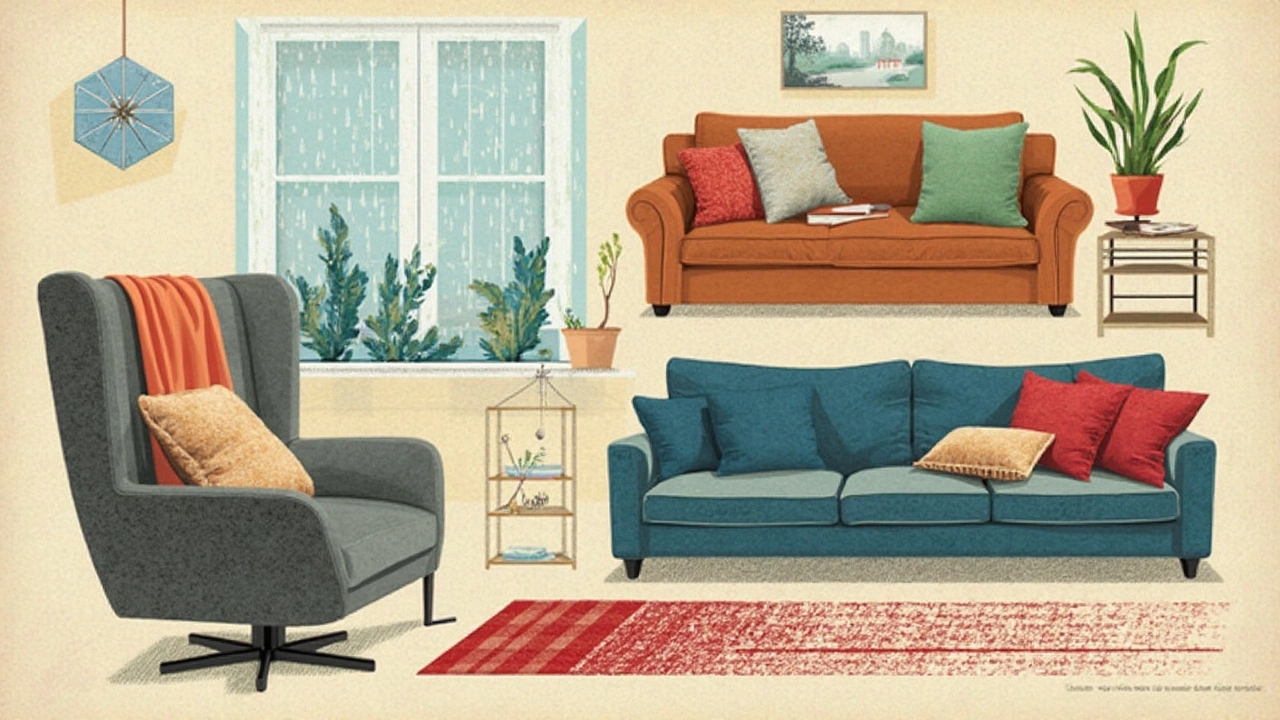 20
Jun,2025
20
Jun,2025
Still hanging onto that saggy old couch from college? You’re not the only one. Most people underestimate how often you should replace your main sofa—partly because it’s tricky to know what’s “normal.” In reality, the average couch lasts about seven to fifteen years, depending on how you treat it and what it’s made from. Some folks try to stretch it to twenty, but at that point, you’re more likely sitting on memories and a little bit of frame.
Think about how much time you spend on your couch—movie nights, pets napping, kids jumping, even the occasional power nap. All of this takes a toll, no matter how nice your couch looked the day it arrived. Load, spills, and sunlight can break down fabric faster than you might expect. Honestly, if your sofa’s giving you back pain or seems slumped over before you do, it’s probably time for a reality check.
- Couch Lifespan: The Real Numbers
- Material Matters: What’s Your Sofa Made Of?
- Signs It’s Time for a New Couch
- Tips to Make Your Couch Last Longer
- Smart Shopping: Choosing Your Next Couch
Couch Lifespan: The Real Numbers
If you’re trying to figure out when to say goodbye to your couch, there’s no magic number—but there are some real stats to go by. Most everyday couches stick around for 7 to 15 years before they give up. That’s what furniture experts and major retailers like to call the “average lifespan.” But that number can go up or down depending on a few key things: what the couch is made of, how hard you use it, and how much love (or abuse) it gets.
The material seriously matters. A cheap frame from particle board won’t hold up like solid hardwood. Fabric sofas tend to wear out faster than leather ones, especially if you’ve got kids or pets jumping on them. Also, the cushions give out before the frame most of the time—no amount of fluffing brings back the bounce once the foam’s broken down.
Here’s a handy breakdown based on what kind of replace couch job you might be looking at:
| Type of Couch | Average Lifespan (Years) |
|---|---|
| Fabric (standard use) | 7 - 10 |
| Fabric (heavy use) | 5 - 8 |
| Leather (standard use) | 10 - 15 |
| Leather (heavy use) | 8 - 12 |
| Sectional/Modular | 7 - 12 |
| Futon/Sleeper Sofa | 5 - 10 |
Sometimes people try to fix up a saggy cushion or duct tape a ripped armrest, but if you’re doing that every few months, it’s a sign your sofa’s running on borrowed time. Another thing—fancier or well-made couches might hit the 15-year or even 20-year mark if you’re gentle and keep up with cleaning. But for most busy families, swapping out the main couch every decade just makes life simpler. No guilt in wanting your living room to look—and feel—good.
Material Matters: What’s Your Sofa Made Of?
When it comes to couches, what’s inside really does count. The type of frame, cushions, and upholstery can make or break how long your couch actually lasts before you feel the itch to upgrade. If you want the best bang for your buck, paying attention to these details isn’t just smart—it’s essential.
The biggest factor is the frame. Hardwood frames (like oak, ash, or beech) hold up better over time compared to cheaper pine or particleboard. A solid frame helps prevent that dreaded wobble or sag after just a few years. Metal frames can be sturdy in modern couches, but they might squeak or loosen with heavy use.
Cushion filling is next. High-density foam usually keeps its shape and bounce for longer, while anything labeled low-density tends to flatten fast. Some couches use a mix of foam and polyester, or even down, but these need regular fluffing or else they look tired in no time. Springs (like sinuous springs or eight-way hand-tied) add both support and longevity.
Upholstery totally changes the game. Leather costs more but can last decades if you keep it clean and out of direct sunlight. Microfiber is tough against spills and stains, so it’s perfect for busy homes with pets or kids. Cotton looks great but can wear thin and show stains pretty quick, while synthetic blends are hit or miss—a good one resists pilling and stretching.
Here’s a quick snapshot of how long popular couch materials hold up on average:
| Material | Typical Lifespan (years) |
|---|---|
| Hardwood Frame & Leather | 12-18 |
| Hardwood Frame & Microfiber | 10-15 |
| Particleboard Frame & Synthetic Fabric | 4-7 |
| Pine Frame & Cotton | 5-8 |
If you want your replace couch timeline to stretch, starting with the right materials goes a long way. Always check the tag, ask questions in the showroom, or look up the brand’s specs online before dropping your cash on a new sofa.

Signs It’s Time for a New Couch
Feeling unsure about whether your couch needs replacing or just a little TLC? There are some clear red flags you shouldn’t ignore. First, sagging cushions are a big one. If you sit down and feel like you’re sinking into a hole, chances are the foam or springs inside have called it quits. Sagging is more than just uncomfortable—it can mess with your posture and your mood.
The next thing to check is the frame. If your couch creaks, wobbles, or feels unstable when you sit or move it, there’s probably hidden damage. A broken or cracked frame can’t be fixed cheaply, and pushing it longer just isn’t safe.
Stains and smells that won’t budge even after a serious cleaning are another clear sign your couch may have reached the end of its life. If you’re fighting against old pet accidents, mustiness, or weird odors that just won’t go away, new upholstery is likely not worth it. Mold and allergens can actually hide deep inside the stuffing.
Keep an eye out for visible fabric wear too. If you’re seeing tearing, fraying, or material that’s thinning down to the threads, you’re not just looking at a cosmetic problem. The structural integrity of the seat is probably fading fast.
Here’s a quick checklist for whether your replace couch moment has arrived:
- Sagging cushions or lumpy seats
- Broken or wobbling frame
- Stubborn stains or lingering odors
- Torn, fraying, or pilling fabric
- New aches or discomfort while sitting
- Strange noises—creaks, groans, or pops when using the couch
- Outgrown style or size—if it no longer fits your space or family needs
If you’re ticking off two or more from this list, investing in a new couch could make your everyday life a whole lot more comfortable (and way better looking for guests).
Tips to Make Your Couch Last Longer
If you’re serious about stretching your couch’s lifespan and saving some cash, there are a few simple habits that will make a difference. Start by rotating the cushions every week. This spreads out the wear and pressure, so one spot doesn’t end up lumpy while the others look brand new. Cushion rotation is one of those moves that really does buy you extra years.
Vacuuming matters too—dust and crumbs can grind into the fabric and actually wear it down faster. Weekly vacuuming with a soft brush attachment keeps the upholstery looking fresh and prevents dust mites from moving in. Don’t forget to get into the cracks; even the fanciest couches start to look tired if there’s old popcorn wedged behind the seat.
Ever notice your friend’s couch gets that weird sun-faded patch? Direct sunlight breaks down fabric color and fibers faster than most people realize. If you can, keep your couch out of constant daylight or use curtains during peak sun hours. Leather especially hates the sun—UV rays dry it out and make it crack.
Messes happen, but the trick is to clean spills right away. Blot (don’t scrub) with a clean towel, then use the cleaner recommended for your fabric. Water-based cleaners work for microfiber, while leather needs its own gentle cleaner. Red wine and juice can set in fast, so don’t wait around.
If you have pets, think about adding a washable throw or pet cover to spots they love. Scratches and fur build up over time, and it’s way easier to toss a cover in the wash than pay for professional cleaning. Plus, your guests don’t have to discover Fido’s collection of “hidden hair” when they visit.
- Rotate and flip cushions weekly.
- Vacuum fabric and cracks every week.
- Keep the couch away from direct sunlight.
- Clean spills as soon as they happen.
- Use washable covers if you have pets or small kids.
A little attention every week keeps your replace couch timeline much farther away. Honestly, it takes less time than a trip for takeout—and your living room will thank you.

Smart Shopping: Choosing Your Next Couch
There’s no sense dropping cash on a new couch just to end up with another sagging disappointment. If you’re in the market, don’t just buy the first one that looks good—there’s real stuff you should check. For starters, frame strength should be a dealbreaker. Solid hardwood like oak, maple, or ash holds up years longer than plastic or softwood. A cheap frame usually means a short lifespan, simple as that.
Cushion quality makes a huge difference too. You want high-density foam for firm support that bounces back, not the kind that flattens after a few Netflix marathons. Look for sinuous (S-shaped) springs or eight-way hand-tied springs inside—their durability beats webbing or nothing at all. And don’t forget fabric: leather lasts, but some synthetics like olefin or microfiber are surprisingly tough against stains and pets. Can’t decide? Performance fabrics often hit the sweet spot between cleanability and comfort.
Here’s a quick look at material lifespans and care needs you can actually use:
| Material | Average Lifespan (Years) | Care Tips |
|---|---|---|
| Genuine Leather | 12-20 | Wipe spills, condition every 6-12 months |
| Microfiber | 8-12 | Vacuum regularly, blot stains |
| Cotton Blend | 7-10 | Spot clean, avoid heavy sun exposure |
| Faux Leather | 5-8 | Damp cloth, avoid sharp objects |
Don’t skip sitting on it in the store—or even lying down if you can sneak it. If you’re shopping online, check the return policy and reviews from real buyers. A “looks awesome” review means nothing if the couch feels like a bench after two weeks.
Don’t forget size. Measure the doorways, halls, elevator, and the actual spot your new couch will live. A stunning sectional means nothing if you can’t get it inside. There’s nothing worse than falling for a couch, and then realizing you have to leave it in the hallway.
Thinking value? Try sales, outlet centers, or even certified pre-owned if you're watching your budget. Some furniture shops sell quality floor samples with big markdowns. Plus, always ask about the warranty. A good couch should have at least a one-year warranty on the frame, but better stores offer five years or more on structure and springs. If a seller’s warranty sounds flimsy, that’s a red flag for real durability.
Whether you want a bold look or something that hides dog fur, keep your real daily life in mind. Durability, comfort, and the right size matter most. If you focus on the backbone features and not just looks, your next replace couch experience could be the best sitting decision you make all year.




